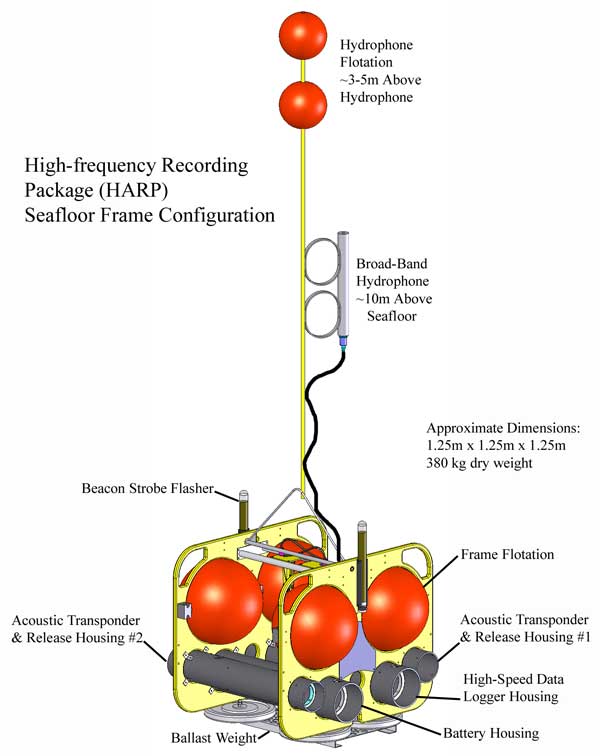Sean M. Wiggins - swiggins@ucsd.edu
Whale Acoustics Lab (http://cetus.ucsd.edu)
Scripps Institution of Oceanography - UCSD
La Jolla, CA 92093-0205
John A. Hildebrand - jhildebrand@ucsd.edu
Scripps Institution of Oceanography - UCSD
La Jolla, CA 92093-0205
Popular version of paper 3aAB1
Presented Wednesday morning, May 20, 2009
157th ASA Meeting, Portland, OR
Whales and dolphins spend a large portion of their lives beneath the sea surface using sound to sense their environment, search for food, and communicate. To better understand these sounds and how they are used, we developed a general purpose underwater sound recorder (High-frequency Acoustic Recording Package HARP) and deployed it at various remote locations around the worlds oceans. These underwater recorders are capable of capturing a wide range of sounds extending from low-pitch blue whale song to high-pitch echolocation pulses used by dolphins for finding food. In addition to sounds from whales and dolphins, sounds from other natural and man-made sources are often recorded such as fish, wind, rain, ships, seismic exploration, and sonar.
A HARP is essentially a high-tech tape recorder with the microphone and tape replaced by a sensitive hydrophone and computer memory. Currently, the recording capacity is approximately 2 terabytes (two-thousand billion bytes) and is provided by an array of 16 laptop-style disk drives. An onboard computer controls the recordings of the autonomous instrument and is powered by batteries.
 |
| Figure 1. High-frequency Acoustic Recording Package - HARP recorder electronics mounted on housing end cap. Recording media are laptop hard disk drives and provide approximately 2 terabytes of data storage. |
Typically, HARPs are deployed from a boat and sink to the seafloor, where they record sounds for periods of months to one year. After the disk drives are full or the batteries are depleted, the boat returns and issues a command through the water to release the HARPs anchor weight, and the instrument floats to the sea surface for recovery. Once onboard, the data disks and batteries are removed and replaced with new ones, and a new anchor weight is attached prior to its next multi-month deployment.
 |
| Figure 2. HARP in a seafloor frame configuration including flotation, anchor weight release system, hydrophone and housing for recorder electronics and batteries. |
Long duration recordings from HARPs reveal a wide breadth of new information on the lives of whales and dolphins. For example, the recordings can show seasonal patterns, such as when migrating whales arrive at feeding grounds and, relatively, how many have arrived. The recordings also can teach us about daily patterns. For instance, in some locations, many species of dolphins appear to feed at night using echolocation clicks but use whistles more during the day. Typically, HARP recorders are placed far apart and sounds recorded on one instrument are not received on another; however, they also can be arranged in close proximity (~ 1km) to form a tracking array that determines an animals location by the time its sound arrives at all the instruments. Swimming behavior of individuals or groups can be inferred from the time sequence of localized whale and dolphin sounds.
HARP recorders also can be used to investigate whale and dolphin responses to exposure to various man-made sound sources. First, baseline recordings are needed to define what normal seasonal and daily sound patterns are for a given species and location. Next, the man-made sounds are played at this location during recordings, and finally recordings are made for an extended period after the man-made sounds were played. The recordings from before, during, and after exposure to man-made sounds show if there is any response in the sound behavior of the studied species.
We continue to advance the capabilities of the HARP recorders to provide additional information on sounds in the ocean. For example, we are working on improvements that will provide detailed diving behavior from echolocation pulses of beaked whales, a species that has shown high sensitivity to sonar. Also, since these recorders rely on battery power to operate, we are working on methods to lower recording power requirements. A recorder that requires less battery power can be smaller and will cost less, so more recorders can be built and deployed for the same amount of funding, potentially providing more information on these fascinating animals and the sound environment in which they live.